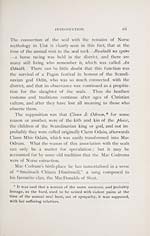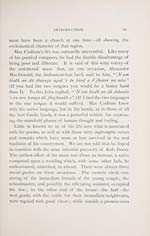Hew Morrison Collection > Poems and songs of John MacCodrum, Archibald MacDonald, and some of the minor Uist bards
(26)
Download files
Complete book:
Individual page:
Thumbnail gallery: Grid view | List view

Vlll INTRODUCTION.
" An Cladh Chòthain rugadh mise
'N Aird a Runair chaidh mo thogail
Fradharc a' chuain uaimhrich chuislich
Nan stuadh guanach cluaineach cluicheach."
The district in which our bard was born and brought up
abounds in ecclesiastical names, and was undoubtedly in
olden days the seat of Church authority in the island.
The church and glel)e of the parish are located there, as
well as more extensive tracts of kirk lands in pre-Reforma-
tion times. The ^'irgin Mary was the patron saint, for the
old name of the parish, as well as the church, was Kilmuir ;
there are the penny lands of Mary, adjacent to the glebe,
called Peighinn Mitire, and it is said that part of the old
vicarage teinds of North Uist, prior to commutation, was a
young seal, designated Cuilleaii Aliiire. Ard-a-Rutiair,
where the poet was brought up, is a promontory jutting out
into the 'Western Sea. The name means the point of the
secretary, or clerk, probably applied to the inferior func-
tionary known as fear-sgriobhaidh in the mediaeval church.
Cladh Chothain, where Mac Codrum was born, lies close by
Aird-a-Runair, a burying-ground named after a well-known
saint, who has also been perpetuated in Kilchoan, Ardna-
murchan, and elsewhere. Not far off is Eilean Drostain,
called after another saint ; and there is a rock quite near
to the poet's birth-place, called Sgeir tia Circe* where there
* (Eng.) Church, (Scot.) Kirk, (Germ.) Kirche, are different forms
of the same word — connected with (Gr.) KvptaKÒs. Hence circle
that being the form of the earliest religious structures.
" An Cladh Chòthain rugadh mise
'N Aird a Runair chaidh mo thogail
Fradharc a' chuain uaimhrich chuislich
Nan stuadh guanach cluaineach cluicheach."
The district in which our bard was born and brought up
abounds in ecclesiastical names, and was undoubtedly in
olden days the seat of Church authority in the island.
The church and glel)e of the parish are located there, as
well as more extensive tracts of kirk lands in pre-Reforma-
tion times. The ^'irgin Mary was the patron saint, for the
old name of the parish, as well as the church, was Kilmuir ;
there are the penny lands of Mary, adjacent to the glebe,
called Peighinn Mitire, and it is said that part of the old
vicarage teinds of North Uist, prior to commutation, was a
young seal, designated Cuilleaii Aliiire. Ard-a-Rutiair,
where the poet was brought up, is a promontory jutting out
into the 'Western Sea. The name means the point of the
secretary, or clerk, probably applied to the inferior func-
tionary known as fear-sgriobhaidh in the mediaeval church.
Cladh Chothain, where Mac Codrum was born, lies close by
Aird-a-Runair, a burying-ground named after a well-known
saint, who has also been perpetuated in Kilchoan, Ardna-
murchan, and elsewhere. Not far off is Eilean Drostain,
called after another saint ; and there is a rock quite near
to the poet's birth-place, called Sgeir tia Circe* where there
* (Eng.) Church, (Scot.) Kirk, (Germ.) Kirche, are different forms
of the same word — connected with (Gr.) KvptaKÒs. Hence circle
that being the form of the earliest religious structures.
Set display mode to: Large image | Transcription
Images and transcriptions on this page, including medium image downloads, may be used under the Creative Commons Attribution 4.0 International Licence unless otherwise stated. ![]()
| Early Gaelic Book Collections > Hew Morrison Collection > Poems and songs of John MacCodrum, Archibald MacDonald, and some of the minor Uist bards > (26) |
|---|
| Permanent URL | https://digital.nls.uk/81340075 |
|---|
| Description | A selection of items from a collection of 320 volumes and 30 pamphlets of literary and religious works in Scottish Gaelic. From the personal library of Hew Morrison, the first City Librarian of Edinburgh. |
|---|
| Description | Selected items from five 'Special and Named Printed Collections'. Includes books in Gaelic and other Celtic languages, works about the Gaels, their languages, literature, culture and history. |
|---|

